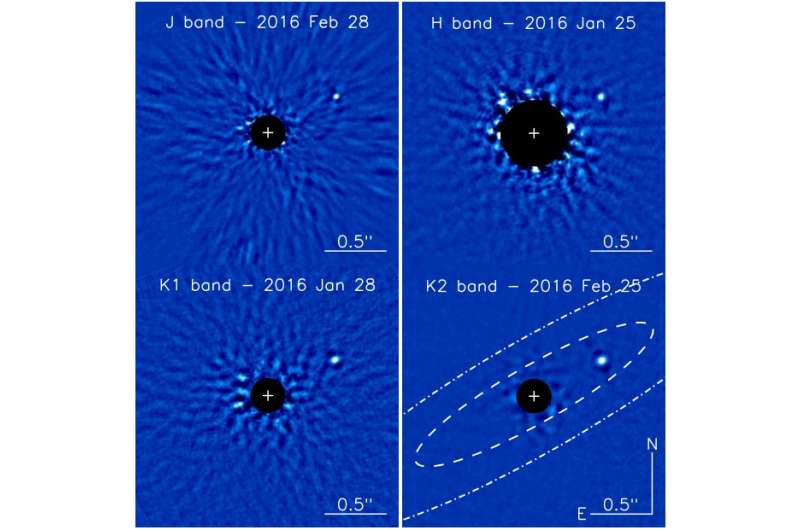August 26, 2016 report
Astronomers find a brown dwarf companion to a nearby debris disk host star

(Phys.org)—Astronomers have detected a brown dwarf orbiting HR 2562 – a nearby star known to host a debris disk. The newly discovered substellar companion is the first brown dwarf-mass object found to reside in the inner hole of a debris disk. The findings were presented in a paper published Aug. 23 on the arXiv pre-print server.
HR 2562, located some 110 light years away, is an F5V star, about 30 percent more massive than the sun. It has a debris disk—a circumstellar belt of dust and planetesimals left over from planetary formation. The disk around HR 2562, spans from 38 to 75 AU away from the host star.
In January and February 2016, a team of researchers, led by Quinn Konopacky of the University of California, San Diego, observed HR 2562 using the Gemini Planet Imager (GPI), mounted on the Gemini South Telescope in Chile. GPI is a high-contrast imaging instrument, allowing imaging and integral field spectroscopy of extrasolar planets. The observations of HR 2562 were conducted as part of the Gemini Planet Imager Exoplanet Survey (GPIES), that images young Jupiters and debris disks around nearby stars.
However, their search for a young, Jupiter-like planet resulted in a discovery of a much more massive substellar object. The data obtained during the observations, allowed the team to confirm the existence of a brown dwarf that could have at least 15 Jupiter masses. The newly found companion is separated by about 20 AU from the host star and was designated HR 2562B.
"We present the discovery of a brown dwarf companion to the debris disk host star HR 2562. This object, discovered with the Gemini Planet Imager, has a projected separation of 20.3±0.3 AU from the star," the researchers wrote in the paper.
Separation by only 20 AU means that HR 2562B lies within the inner hole of the debris disk; significantly, it is the first known brown dwarf residing inside such a gap. The scientists also noted that so far, only few substellar companions have been imaged within 100 AU from their host stars.
While the separation of HR 2562B has been precisely estimated, its mass remains uncertain. The scientists revealed that its minimum mass is at least 15 Jupiter masses. However, the brown dwarf could be even 45 times more massive than Jupiter as well. Thus, the mean value was calculated to be 30 Jupiter masses.
Moreover, the host star's age also remains to be determined, as previous observations delivered conflicting results, ranging from 20 million to even 1.6 billion years. However, for the purposes of the recent study, the team adopted a nominal age range of 300 to 900 million years.
The findings published by Konopacky and her team, could be helpful to better understand the formation process of circumstellar companions; it is widely debated whether these objects form within a circumstellar disk and reach a mass above the deuterium burning limit or via cloud fragmentation, as in binary systems with a high mass ratio.
The researchers concluded that future studies of the HR 2562 system should focus on constraining the true mass and orbit of the companion. It could be essential to determine its possible origin, which could offer evidence of planet formation above the deuterium burning limit.
More information: Discovery of a Substellar Companion to the Nearby Debris Disk Host HR 2562, arXiv:1608.06660 [astro-ph.EP] arxiv.org/abs/1608.06660
Abstract
We present the discovery of a brown dwarf companion to the debris disk host star HR 2562. This object, discovered with the Gemini Planet Imager (GPI), has a projected separation of 20.3±0.3 au (0.618±0.004") from the star. With the high astrometric precision afforded by GPI, we have confirmed common proper motion of HR 2562B with the star with only a month time baseline between observations to more than 5σ. Spectral data in J, H, and K bands show morphological similarity to L/T transition objects. We assign a spectral type of L7±3 to HR 2562B, and derive a luminosity of log(Lbol/L⊙)=-4.62±0.12, corresponding to a mass of 30±15 MJup from evolutionary models at an estimated age of the system of 300-900 Myr. Although the uncertainty in the age of the host star is significant, the spectra and photometry exhibit several indications of youth for HR 2562B. The source has a position angle consistent with an orbit in the same plane as the debris disk recently resolved with Herschel. Additionally, it appears to be interior to the debris disk. Though the extent of the inner hole is currently too uncertain to place limits on the mass of HR 2562B, future observations of the disk with higher spatial resolution may be able to provide mass constraints. This is the first brown dwarf-mass object found to reside in the inner hole of a debris disk, offering the opportunity to search for evidence of formation above the deuterium burning limit in a circumstellar disk.
© 2016 Phys.org





















